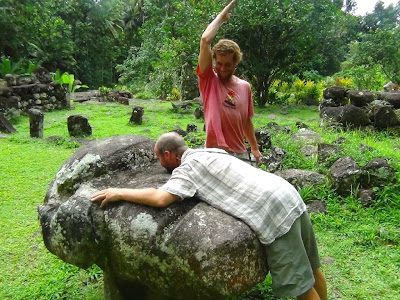Who would have thought we would still be eating Greek salad, with fresh green pepper, cucumber, tomato, red onion, black olives and Chiapas cheese, 30 days after provisioning in La Paz?
Living without a fridge for the last three years in the hot climate of Mexico has taught us a few things. We have learned to choose fresh vegetables and fruits with a discerning eye, preferring to buy non-refrigerated produce from the farmers' market. The Mexican vendors do not mind if we handle the produce to avoid bruised or over-ripe fruits/veggies. We have also discovered "new" vegetables, which naturally keep longer, like chayote (a good zucchini substitute) and jicama.
Once onboard, we carefully wrap each delicate item in brown paper, cut-up bags we had saved from bakery and wine purchases. Newspaper also works but glossy magazine paper is not good because it does not breathe. Our produce locker has stacking plastic baskets with holes in the sides for airflow and we almost always leave the lid off this locker to allow air in. These two steps seem to help prevent the goods from chafing and going moldy, keeping things dark but ventilated and not too dry.
This voyage to Polynesia is on a different scale from our usual 2 or 3 week Mexican stints. We bought enough produce to last 4-5 weeks, in case we got stuck in the doldrums, and were prepared to sacrifice some along the way. The oranges and apples were hung in hammocks, the vegetables split between the galley produce locker and an open Rubbermaid container under the quarter berth. I unwrapped and aired vegetables, other than potatoes and onions, every day or second day, depending on the sea state. We placed the most ripe tomatoes, green peppers, cauliflower and avocados in the fridge, once space became available, 7-10 days after leaving La Paz. The same applies to cut vegetables which have been partially used, like cucumber for example.
Our loss has been minimal - in more than 4 weeks of sailing - two grapefruits, one orange, one tomato and several carrots. We ate the last zucchini two days ago and still have kilos of onions and potatoes, several cukes, some carrots, cabbages, jicama, chayote, poblano peppers, and even a few tomatoes and an avocado. Admittedly, the carrots and peppers look rather gnarly. In the fruit department, we have ten oranges, lots of limes and a few dozen 5000 mile apples from Washington (via Mexico). No scurvy victims on Ladybug!
Now - we just have to get through Friday the 13th and hope that when we make landfall, the inspectors in French Polynesia allow us to keep our hard earned veggies and fruit!
More on favourite at sea recipes at a later date as I am feeling a bit nauseous in the bouncy seas today.
Our position at 1430 Zulu on Friday April 13 was 8 12 S 136 35 W. We sailed 136 NMs in the last 24 hours and are 155 NMs out of Hiva Oa. Note that the captain had us going to the wrong waypoint (40 miles east of where we should have been aiming), so our previous entries for miles to run are wrong and we will probably reach Atuona by tomorrow afternoon. He should leave the navigation to the first mate :)






























































